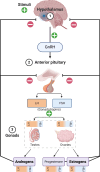Immune dynamics throughout life in relation to sex hormones and perspectives gained from gender-affirming hormone therapy
- PMID: 39885993
- PMCID: PMC11779622
- DOI: 10.3389/fimmu.2024.1501364
Immune dynamics throughout life in relation to sex hormones and perspectives gained from gender-affirming hormone therapy
Abstract
Biological sex is closely associated with the properties and extent of the immune response, with males and females showing different susceptibilities to diseases and variations in immunity. Androgens, predominantly in males, generally suppress immune responses, while estrogens, more abundant in females, tend to enhance immunity. It is also established that sex hormones at least partially explain sex biases in different diseases, particularly autoimmune diseases in females. These differences are influenced by hormonal, genetic, and environmental factors, and vary throughout life stages. The advent of gender-affirming hormone therapy offers a novel opportunity to study the immunological effects of sex hormones. Despite the limited studies on this topic, available research has revealed that testosterone therapy in transgender men may suppress certain immune functions, such as type I interferon responses, while increasing inflammation markers like TNF-α. Transgender women on estrogen therapy also experience alterations in coagulation-related and inflammatory characteristics. Furthermore, other possible alterations in immune regulation can be inferred from the assessment of inflammatory and autoimmune markers in transgender individuals receiving hormone therapy. Understanding the complex interactions between sex hormones and the immune system, particularly through the unique perspective offered by gender-affirming hormone therapies, may facilitate the development of targeted therapies for infections and autoimmune diseases while also improving healthcare outcomes for transgender individuals. Here we review immune dynamics throughout life in both sexes and provide a summary of novel findings drawn from studies exploring gender-affirming hormone therapy.
Keywords: androgens; autoimmune diseases; estrogens; gender-affirming hormone therapy; immune system; infectious diseases; sex difference.
Copyright © 2025 Yalcinkaya, Yalcinkaya, Sardh and Landegren.
Conflict of interest statement
The authors declare that the research was conducted in the absence of any commercial or financial relationships that could be construed as a potential conflict of interest.
Figures




Similar articles
-
Epigenetic remodeling by sex hormone receptors and implications for gender affirming hormone therapy.Front Immunol. 2025 May 8;16:1501959. doi: 10.3389/fimmu.2025.1501959. eCollection 2025. Front Immunol. 2025. PMID: 40406098 Free PMC article. Review.
-
Gender-Affirming Hormone Therapy, Vascular Health and Cardiovascular Disease in Transgender Adults.Hypertension. 2019 Dec;74(6):1266-1274. doi: 10.1161/HYPERTENSIONAHA.119.13080. Epub 2019 Oct 28. Hypertension. 2019. PMID: 31656099 Free PMC article. Review.
-
Immune system adaptation during gender-affirming testosterone treatment.Nature. 2024 Sep;633(8028):155-164. doi: 10.1038/s41586-024-07789-z. Epub 2024 Sep 4. Nature. 2024. PMID: 39232147 Free PMC article.
-
Effect of cross-sex hormones on the quality of life, depression and anxiety of transgender individuals: a quantitative systematic review.JBI Database System Rev Implement Rep. 2019 Sep;17(9):1826-1854. doi: 10.11124/JBISRIR-2017-003869. JBI Database System Rev Implement Rep. 2019. PMID: 31021971
-
Sex and Gender Considerations in Episodic Migraine.Curr Pain Headache Rep. 2022 Jul;26(7):505-516. doi: 10.1007/s11916-022-01052-8. Epub 2022 Jun 9. Curr Pain Headache Rep. 2022. PMID: 35679008 Free PMC article. Review.
Cited by
-
Gene Expression Changes as Biomarkers of Immunosenescence in Bulgarian Individuals of Active Age.Biomedicines. 2025 Mar 15;13(3):721. doi: 10.3390/biomedicines13030721. Biomedicines. 2025. PMID: 40149697 Free PMC article.
-
Parathyroidectomy Positively Modulates Systemic Inflammation and Nutritional Status: Immune-Inflammation Index and Prognostic Nutritional Index in Primary Hyperparathyroidism.Medicina (Kaunas). 2025 Jul 8;61(7):1236. doi: 10.3390/medicina61071236. Medicina (Kaunas). 2025. PMID: 40731865 Free PMC article.
-
Molecular insights into gender-specific differences in rheumatoid arthritis: A study using high-throughput sequencing and Mendelian randomization.Medicine (Baltimore). 2025 Jun 20;104(25):e42960. doi: 10.1097/MD.0000000000042960. Medicine (Baltimore). 2025. PMID: 40550064 Free PMC article.
-
Sex Differences in Immune Responses to Infectious Diseases: The Role of Genetics, Hormones, and Aging.Diseases. 2025 Jun 7;13(6):179. doi: 10.3390/diseases13060179. Diseases. 2025. PMID: 40558589 Free PMC article. Review.
-
Impact of menopausal hormone therapy on influenza complications in women: a systematic assessment study.Ann Med. 2025 Dec;57(1):2534095. doi: 10.1080/07853890.2025.2534095. Epub 2025 Jul 17. Ann Med. 2025. PMID: 40676907 Free PMC article.
References
Publication types
MeSH terms
Substances
LinkOut - more resources
Full Text Sources
Medical

